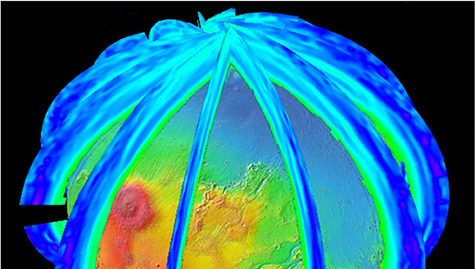
Roger J. Phillips, PhD, a scientist at the Southwest Research Institute in Boulder, Colo., and director emeritus of the McDonnell Center for the Space Sciences, will deliver the McDonnell Distinguished Lecture on Wednesday, April 15, at Washington University in St. Louis.
The lecture, titled “No Denying Climate Change on Mars,” will begin at 7 p.m. in Room 100 of Whitaker Hall. Sponsored by the university’s McDonnell Center for the Space Sciences, the event is free and open to the St. Louis community.
Mars once had an atmosphere roughly as dense as Earth’s but it was too puny to hang onto it. When it lost its atmosphere, Mars lost its ability to maintain a temperature above the freezing point of water. So the planet once awash in surface waters became an ice world.
“Even with a thin atmosphere, Mars undergoes significant climate change,” Phillips said.
“It does so by experiencing Milankovitch cycles ‘on steroids,’” he said. “These are periodicities in a planet’s orbital and rotation properties that on Earth cause glacial and interglacial periods in the present Ice Age.
“On Mars, the same phenomena occur. The tilt of the spin axis (obliquity) is more pronounced than on Earth, plus it has a strong chaotic component.
“Given Mars’ thin atmosphere, obliquity variations can lead to sublimation of the entire north polar water ice cap and the deposition of that material at mid-latitudes, where water-ice glaciers form.
“More recently, a sounding radar has discovered a massive solid carbon dioxide (dry ice) deposit in the south polar cap, indicating that, driven by obliquity variations, the atmosphere completely vanishes from time to time. To top that, dry-ice glaciers flow downhill from high points in the cap.
A planetary geodynamicist, Phillips has studied Mercury, Venus, Mars, Earth and the moon. He was involved with eight planetary missions, including Magellan, the Mars Global Surveyor, MESSENGER, and the Mars Reconnaissance Orbiter.

He earned an undergraduate degree in geology from the Colorado School of Mines and master’s and doctoral degrees in applied geophysics from the University of California, Berkeley.
He began his career at the Jet Propulsion Laboratory, where he worked from 1968 until 1980 in various capacities. From 1979 to 1982, he was director of the Lunar and Planetary Institute in Houston.
In 1982, he moved to Southern Methodist University, where he was the Matthews Professor of Geophysics. In 1992, he moved to St. Louis to take up a dual position as a professor of geophysics in the Department of Earth and Planetary Sciences and as director of the McDonnell Center for the Space Sciences.
Now professor emeritus, he became a senior scientist at the Southwest Research Institute in 2008.
A fellow of the American Geophysical Union (AGU) and the Geological Society of America (GSA), he has won GSA’s G.K. Gilbert Award, the AGU’s Whipple Award and been awarded a NASA Public Service Medal.
The McDonnell Center, established in 1975 through a gift from aerospace pioneer James S. McDonnell, is a consortium of Washington University faculty, research staff and students, primarily from the earth and planetary sciences and physics departments, both in Arts & Sciences. They are working on the cutting edge of space sciences research.
For more information, contact Trecia Stumbaugh at trecia@wustl.edu or 314-935-5332.